Images of Family in the Magic Lantern
Since the Edo period (1603–1868), “magic lanterns”—devices that project enlarged still images using a light source and a lens—prospered in their own unique way and spread widely as an iconic form of audio-visual educational media in the Meiji period (1868–1912). As the age of cinema arrived, use of the magic lantern seemed to decline. However, starting with its wartime revival, the magic lantern had a unique presence in educational institutions and social movements throughout the Occupation and the 1950s, as shown by countless independent productions and screenings. Following “Seasons of Magic Lantern 2” in 2011, this special screening program will show five roll-format magic lantern filmstrips that project images of “family” in postwar Japan from a variety of angles.
Co-presented by the Collaborative Research Center for Theatre and Film Arts of Waseda University 2013 Research Project, “Revival and re-development of gentou (slides) in Showa period Japan” (Principal researcher: Washitani Hana)
Supported by the Mitsubishi Foundation
In cooperation with the Kobe Planet Film Archive, the International Institute for Children’s Literature, Osaka, and the Open Research Center for Minamata Studies of Kumamoto Gakuen University
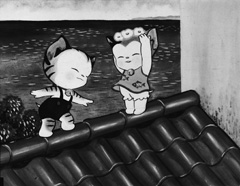 Tora-chan and the Bride
Tora-chan and the Bride
- Production Year Unknown
Production: Konishiroku Photo Industry Co., Ltd.
Script: Matsuzaki Yoshihito
Illustrations: Furusawa Hideo
This is a magic-lantern filmstrip version of a short animated film with the same title (1948, B&W) directed by Masaoka Kenzo and produced by Nihon Doga Seisaku (Japan Movie Productions). The drawings are the work of Furusawa Hideo, a well-known animator who also worked as a manga artist. With a story that centers around the marriage of Tora-chan’s elder sister, this film promotes awareness of the freedom to marry for love under the postwar constitution. (Kamiya Makiko)
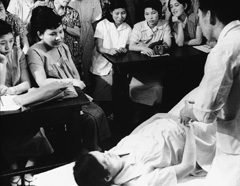 Painless Childbirth, Part 1: Understanding Painless Labor
Painless Childbirth, Part 1: Understanding Painless Labor
- Circa 1955
Supervisors: Japanese Red Cross Maternity Hospital, Sugai Masatomo, Sha Kokuken
Photography: Sato Shozo
Cartoons: Hayase Jiro
Drawings: Ueno Takeo
Producer: Tanigawa Yoshio
Cooperation: Sojusha
Production: Seieisha
Owned by Kobe Planet Film Archive
This filmstrip educates viewers about the “psychoprophylactic method of painless childbirth” from the Soviet Union, which gained attention as an element of the Soviet medical science that found acceptance in post-occupation Japan. The filmstrip explains that by removing anxiety and preconceived notions of pregnancy and delivery through prenatal education, it is possible to experience painless childbirth without the use of anesthesia. This film is an intriguing illustration of the ideological struggle revolving around pregnancy and childbirth. (Washitani Hana)
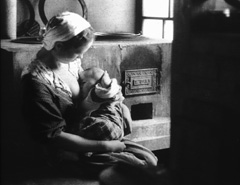 Lifestyle Improvements—the Role of the Wife: Life for Women in Farming Families
Lifestyle Improvements—the Role of the Wife: Life for Women in Farming Families
- 1954
Production: Kurashi no kufu Production Committee
Cooperation: Maruoka Hideko, Yaguchi Mitsuko
Cast: Abe Zenyu Family (Takiyama Village)
Distribution: Asahi Slide Co., Ltd.
* Original print owned by Kobe Planet Film Archive (Cooperation: IMAGICA West)
This filmstrip was intended as a lifestyle improvement guide for farming villages. The setting of this film is a farming village in Yamagata prefecture. It features a real family as it highlights the improved status and awareness of women in farming families. The Life Improvement Department of the Ministry of Agriculture and Forestry, established in 1948 as part of the GHQ agricultural democratization policy, participated in the production of this filmstrip, which received the 3rd Yomiuri Slide Cultural Award in 1954. (Kamiya Makiko)
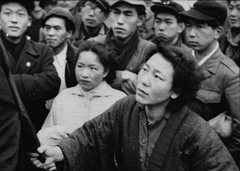 Nikoyon
Nikoyon
- Circa 1955
Production: All Japan Free Trade Union, Iidabashi Free Trade Union
Script, Direction, Photography: Masuya Shintaro
Distribution: Nihon Gento Bunkasha
Owned by Kobe Planet Film Archive
This film is a semidocumentary produced and acted in by day laborers known as nikoyon. After much debate with his coworkers, Masuya Shintaro, who wrote, directed and shot this film, revised the screenplay to feature female laborers as the main characters, something that was highly unusual at the time. The film was produced in conjunction with a fund-raising campaign, taking seven months to complete. (Kamiya Makiko)
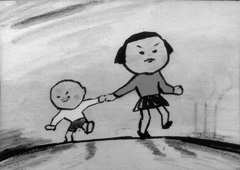 Daddy Went on a Bicycle
Daddy Went on a Bicycle
- 1956
Production: The University of Tokyo Settlement, Kawasaki Society for the Children
Drawing, Script: Kako Satoshi
Distribution: Nihon Gento Bunkasha
* Original print owned by The Open Research Center for Minamata Studies of Kumamoto Gakuen University (Cooperation: IMAGICA West)
Prior to making his debut as an author of picture books for children, Kako Satoshi independently produced this filmstrip, which sprang from his involvement with the University of Tokyo Settlement Kawasaki Children’s Association and was made with the help of local children. Basing the story on the writings and drawings of children who were orphaned as the result of work-related accidents, the filmmaker would conduct numerous interviews and debates before completing the film. (Washitani Hana)
